Tool-Using Animals
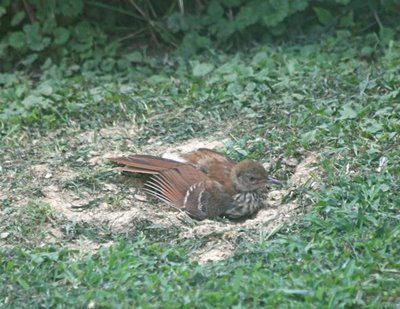
Dust bathing helps birds control parasites such as feather mites and lice. Dust particles get under the scutes of mites and lice, causing the parasites such discomfort that they drop off. It's the same principle that makes dolomitic earth (derived from the silicon-based skeletons of microscopic sea creatures) such an effective pest control. Why use poisons when an irritant will do the job? Both dust and dolomitic earth are non-toxic.
I've noticed that certain bird species are really into dust bathing. Wild turkeys, ruffed grouse (indeed, all the gallinaceous birds); house sparrows, chipping sparrows and brown thrashers are the big dust bathers in our yard. I'm delighted when a dust bath develops within sight of a window, as it has this year.
Brown thrashers have been the instigators in creating a dust bowl in our side yard. We have a family of recently-fledged thrashers in the yard, and we see them dust bathing several times a day. I took these pictures through a double-paned window, so they're no great shakes, but they're amusing anyway.
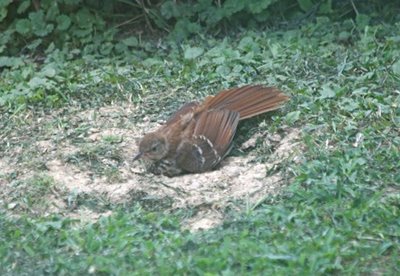
A dust bathing bird goes through the same ritualistic motions that it does when it's in water--dipping the head, scrubbing the breast around, and ruffling its wings so as to send the bathing medium, be it dust or water, through the plumage.
It turns and wallows in circles.
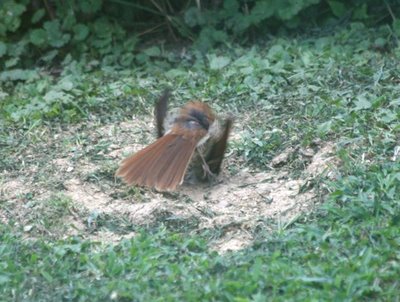
This thrasher, having completed its toilette, did something I found very interesting. It zeroed in on a couple of large chunks of dry clay and, with a few strikes of its strong bill, pulverized them, creating more dust for the bath.
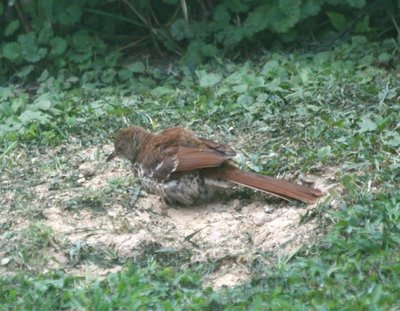 Here, it is pecking a clod into pieces.
Here, it is pecking a clod into pieces.To me, this behavior--seeking out and pulverizing clods of dirt-- suggests that the thrasher realizes that, in order to have ample dust for the bath, he's got to create more. It seems to me to represent tool-making, if the dust so created could be regarded as a tool for feather maintenance.
Traditionally, one of the distinguishing characteristics of the human species was the ability to create and use tools. Through the work of such ethologists as Jane Goodall (who first observed chimps using grass stems to fish for termites), Bernd Heinrich (who has documented tool use in ravens) and a host of other scientists who have found birds and animals consciously employing tools in their everyday life, that distinction has ceased to be the exclusive property of Homo sapiens. Egyptian vultures hurl rocks to break ostrich eggs; green herons, tri-colored herons, black-crowned night herons and great blue herons--my own observation adding them to the list of baitfishing species--use bread as bait for the fish they eat.
I lifted the following from Wikipedia.
The following observations were made by a team led by Thomas Breuer of the Wildlife Conservation Society in September 2005. Gorillas are now known to use tools in the wild. A female gorilla in the Nouabalé-Ndoki National Park in the Republic of Congo was recorded using a stick as if to gauge the depth of water whilst crossing a swamp. A second female was seen using a tree stump as a bridge and also as a support whilst fishing in the swamp. This means that all of the great apes are now known to use tools.
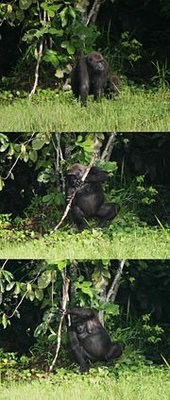 Here is a gorilla seeking out and creating a tool appropriate for her pre-meditated purpose--as a depth gauge for crossing a stream. I found these photos profoundly moving, especially the last one, in which the line between gorillas and humans seems, but for a bit of hair and some skin color, to disappear.
Here is a gorilla seeking out and creating a tool appropriate for her pre-meditated purpose--as a depth gauge for crossing a stream. I found these photos profoundly moving, especially the last one, in which the line between gorillas and humans seems, but for a bit of hair and some skin color, to disappear.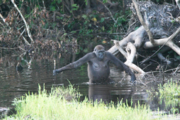
Labels: animal intelligence, brown thrasher, dust bathing bird, gorilla tool use, tool-using animals





